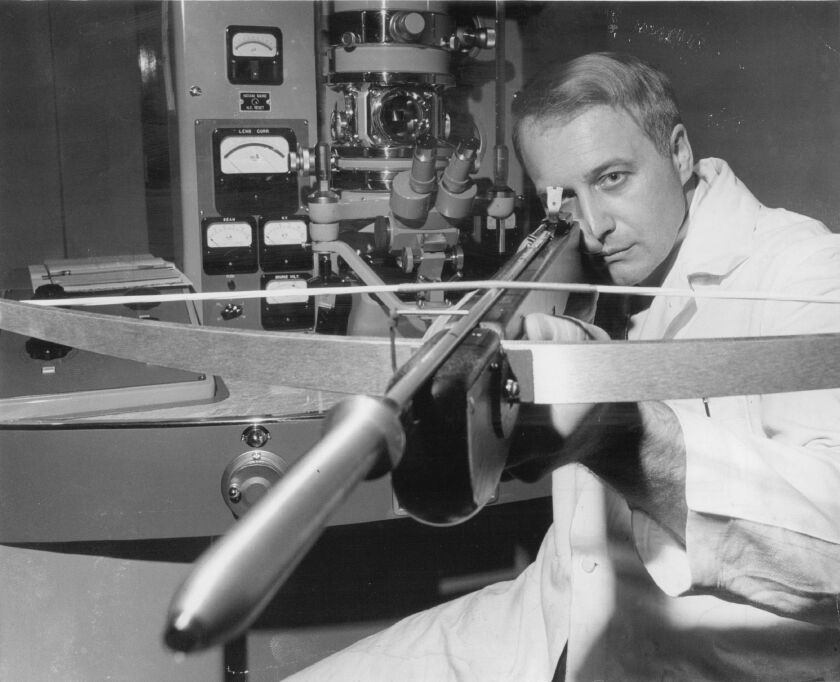In 1970, College of Chicago scientist Roy P. Mackal and his group lowered six waterproof cameras into the chilly gloom of Loch Ness in hopes of as soon as and for all proving the existence of its most well-known inhabitant.
When Nessie chomped one of many “bait” traces secured to every Kodak Instamatic digital camera, Mackal hoped, it might set off a flash bulb and the clicking of a shutter.
The elusive creature by no means obliged, however earlier this yr, a British unmanned sub being put by way of its paces within the loch by chance snagged one of many cameras and introduced it again to the floor.
“It’s nonetheless bone dry inside,” mentioned Adrian Shine, talking to the Chicago Solar-Occasions by telephone this week from his residence close to the shores of Loch Ness.
Shine, a Loch Ness professional and writer of “A Pure Historical past of Sea Serpents,” amongst different books, helped determine the digital camera, housed in a transparent plastic cylinder. He knew Mackal, an eccentric biochemist who additionally led two expeditions in quest of Mokele-mbembe, a rumored residing dinosaur of the Congo.
Adrian Shine, who lives close to the shores of Loch Ness in Scotland, examines an underwater digital camera system developed by College of Chicago Prof. Roy P. Mackal. The U. of C. microbiologist dropped six such cameras into Loch Ness 55 years in the past, in hopes of capturing photos of the illusive Loch Ness Monster.
Nationwide Oceanography Centre
Shine mentioned the movie from the just-retrieved digital camera revealed nothing attention-grabbing — simply murky water from the 750-foot-deep loch.
However Mackal? “He was a really colourful character,” Shine mentioned.
To say the least. Mackal favored bush jackets and made his manner by way of the jungle with “10 Pygmy porters,” in response to Individuals journal. Mackal, who died in 2013 at age 88, made “groundbreaking discoveries in regards to the smallest microbes on earth … however he wished one thing larger, wilder, capable of devour him,” wrote Maureen Searcy in a 2021 UChicago Journal profile of Mackal.
Mackal was drawn to the pseudoscience of cryptozoology, whose adherents search creatures that many would regard as pure fantasy.

Roy P. Mackal was a colourful and controversial scientist on the College of Chicago. Amongst different issues, he was an explorer and had traveled to Scotland to see if he might proved the existence of the Loch Ness Monster. Right here, a while within the late Sixties, he demonstrates a “biopsy dart” he deliberate to make use of within the loch.
Chicago Solar-Occasions file photograph.
“Mackal’s ardour for cryptozoology got here at a excessive skilled price. He didn’t lose his job at UChicago — he was protected by tenure — however he was scorned by his colleagues and his status as a biochemist plummeted,” Searcy wrote. “In the meantime, as his cryptozoology work appeared in The New York Occasions, Individuals journal, and Arthur C. Clarke’s Mysterious World, Mackal rose to stardom as a ‘monstrologist.’”
Mackal honed in on Loch Ness throughout a trip there within the mid-Sixties, Shine mentioned. He noticed a automotive with a digital camera on its roof and determined a greater answer could be to place cameras underwater. However an elaborate system involving buoys and contemporary fish pouches as bait didn’t work. In truth, three of the cameras have been misplaced in a gale.
“The key of Loch Ness was to not be unlocked presently by self portraits,” Mackal wrote in his 400-page e-book, “The Monsters of Loch Ness: The First Full Scientific Research and its Startling Conclusions.”
Nonetheless, Mackal mentioned he as soon as noticed Nessie with out the help of a digital camera.
“It was 6 p.m., and the loch was flat and calm,” he mentioned in a 1985 Solar-Occasions interview. “Abruptly, the water close to my boat began to boil and churn, and the again of an animal surfaced, rising 8 toes out of the water. The pores and skin was slick and black and really clean. I noticed one thing like a flipper protruding from the pores and skin. Then, with an enormous splash, it was gone.”
Shine, for his half, describes himself as a “sympathetic skeptic” in terms of the Scottish monster.
“I discover the time period believer or disbeliever irritating,” he mentioned. “I regard these as non secular attitudes.”


